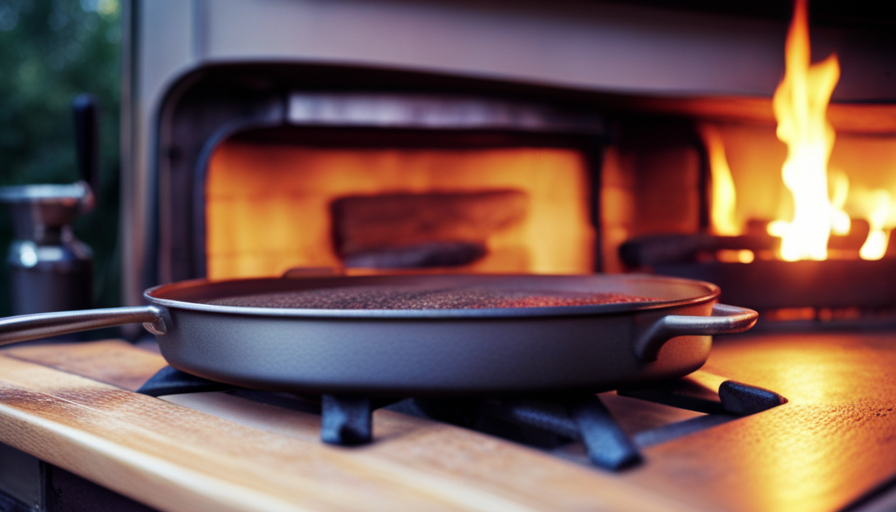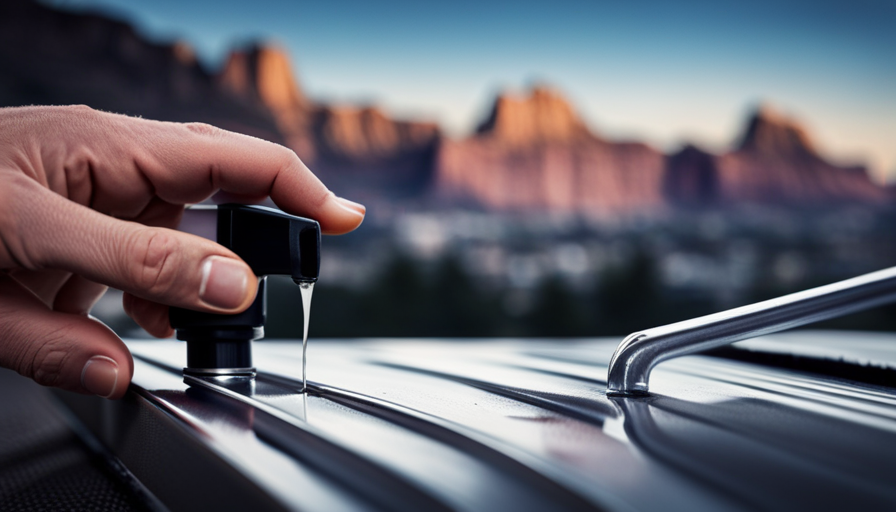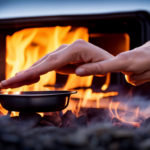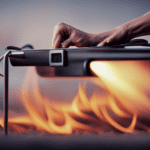Firing up the stove in a camper van sets you on a brief but exciting culinary adventure surrounded by nature. The comforting heat from the stove promises delicious meals and cozy, memorable moments to come. Nonetheless, safety is paramount during this journey. The first steps should involve checking for any gas leaks and ensuring proper ventilation for this delightful venture.
Armed with the necessary tools and supplies, I will guide you through the art of lighting a camper oven with ease. From familiarizing yourself with the oven controls to igniting the pilot light, I will provide detailed instructions to ensure success. Preheating the oven, placing your dish with care, and monitoring the cooking process are essential to achieving culinary perfection.
And once the delectable creation emerges, it’s crucial to turn off the oven and clean up like a seasoned camper. So, let’s dive into the world of camper oven lighting, where delicious meals and unforgettable camping experiences await.
Key Takeaways
- Prioritize safety by checking for gas leaks and ensuring proper ventilation before lighting a camper oven.
- Gather the necessary tools and supplies, including a lighter or matches, oven mitts or heat-resistant gloves, and a flashlight.
- Familiarize yourself with the oven controls, such as the temperature dial and other settings.
- Preheat the oven for 10-15 minutes before cooking to ensure it is evenly heated and ready for use.
Safety First: Check for Gas Leaks and Proper Ventilation
Before you light the camper oven, make sure you check for any gas leaks and ensure proper ventilation to ensure your safety. Gas leaks can pose a serious threat, so it’s crucial to detect them before using the oven.
Start by turning off all gas appliances and shutting off the gas supply to the camper. Then, use a gas leak detection solution or a mixture of soap and water to inspect all gas connections, valves, and hoses. Apply the solution to these areas and look for any bubbles or hissing sounds, which indicate a leak. If you detect a leak, don’t attempt to light the oven and consult a professional for repairs.
Proper ventilation is also essential when using a camper oven. Make sure all windows and vents are open to allow fresh air to circulate. This prevents the accumulation of carbon monoxide, a colorless and odorless gas that can be dangerous if inhaled in high concentrations. Carbon monoxide poisoning can lead to dizziness, headaches, and even death. So, always make sure there’s adequate ventilation in the camper before using the oven.
Now that you’ve taken care of gas leak detection and ventilation, it’s time to gather your tools and supplies for lighting the camper oven.
Gather Your Tools and Supplies
Once you’ve got all your essentials at hand, it’s time to embark on your culinary adventure in the cozy confines of your mobile kitchen. Before you begin, gather the necessary tools and equipment to ensure a smooth cooking experience. You’ll need a lighter or matches, oven mitts or heat-resistant gloves, and a flashlight in case you need to check the oven’s interior. It’s also a good idea to have a fire extinguisher nearby for any emergencies.
Now that you have your tools ready, let’s talk about safety precautions. Make sure the camper is parked on a level surface and the oven is properly ventilated to prevent the buildup of dangerous fumes. Check for any gas leaks by using a solution of soapy water on the connections. If you see bubbles forming, there’s a leak that needs to be fixed before proceeding.
With your tools and safety precautions in place, you’re ready to move on to the next step: familiarizing yourself with the oven controls.
Familiarize Yourself with the Oven Controls
Now that you’ve gathered your tools and ensured safety precautions, it’s time to get acquainted with how the controls of your mobile kitchen’s oven work. Familiarize yourself with the oven controls to ensure smooth operation and avoid any mishaps.
Start by locating the control panel, usually located on the front of the oven. It will typically consist of a temperature dial, a timer, and various other settings.
To use the oven, turn the temperature dial to the desired temperature. Some ovens have specific temperature settings, while others may have a range of temperatures to choose from. Once you’ve set the temperature, give the oven a few minutes to preheat before placing your food inside.
In addition to the temperature dial, there may be other settings such as a broil function or a convection option. Take the time to read the oven’s manual or consult online resources to fully understand the functionality of these settings.
Now that you’re familiar with the oven controls, it’s time to turn on the gas supply. This step is crucial to ensure that the oven will ignite properly and provide the necessary heat for cooking.
Turn on the Gas Supply
To get your mobile kitchen cooking, it’s time to fire up the gas supply and ignite the oven for a delicious culinary adventure! Here’s how to turn on the propane and light the burner:
-
Locate the propane tank: The first step is to find the propane tank, which is usually located outside the camper. Make sure the tank is securely connected to the camper’s gas line.
-
Open the propane valve: Turn the valve on the propane tank counterclockwise to open it. This will allow the propane gas to flow into the camper’s gas line.
-
Turn on the oven burner: Once the propane valve is open, go inside the camper and locate the oven controls. Turn the oven dial to the desired temperature and push it in to ignite the burner. You should hear a clicking sound as the burner ignites.
Now that the gas supply is turned on and the burner is lit, it’s time to ignite the pilot light. This will ensure that the oven stays lit and continues to provide heat for your cooking needs.
Ignite the Pilot Light
With a flicker of flame, the spark of the pilot dances to life, casting a warm glow in the heart of your mobile kitchen. Igniting the pilot light in your camper oven is crucial to get the cooking process started.
There are a few different ignition methods you can use, depending on the model of your oven. One common method is to turn the oven knob to the pilot position and hold a lit match near the pilot light assembly until it ignites. Another method is to use a built-in igniter button, which creates a spark to light the pilot.
If you’re having trouble igniting the pilot, make sure the gas supply is turned on and check for any blockages in the pilot assembly. Sometimes, the pilot light may go out unexpectedly, so it’s important to know how to troubleshoot. You can try relighting the pilot using the same method, or consult your oven’s manual for specific troubleshooting tips.
Once the pilot light is lit, you can move on to adjusting the flame and temperature for your cooking needs.
Adjust the Flame and Temperature
Get ready to take control of your culinary creations by adjusting the flame and temperature to suit your cooking needs. Here are three simple steps to help you achieve the perfect cooking conditions in your camper oven:
-
Adjusting Flame Size: Start by locating the flame adjustment knob, usually found near the pilot light. Turn the knob to increase or decrease the flame size. A larger flame will provide more heat, while a smaller flame will give you a lower temperature. It’s important to find the right balance to ensure even cooking.
-
Oven Temperature Control: Once you’ve set the flame size, you can now adjust the oven temperature. Look for the temperature control knob, typically located on the front panel of the oven. Turn the knob to your desired temperature, following the markings on the dial. Give the oven a few minutes to reach the set temperature before placing your food inside.
-
Preheat the Oven: Now that you have adjusted the flame and temperature, it’s time to preheat the oven. Simply let the oven run for about 10-15 minutes at the desired temperature before you start cooking. This will ensure that the oven is evenly heated and ready to go.
By mastering the art of adjusting the flame size and oven temperature control, you’ll be well on your way to creating delicious meals in your camper oven. Next, let’s move on to the important step of preheating the oven.
Preheat the Oven
Now, it’s crucial to ensure the oven is properly heated before you start cooking. Preheating the oven is an essential step in achieving perfectly cooked meals in your camper.
To ensure your oven is preheated to the right temperature, follow these preheating tips. First, check the oven temperature control and set it to the desired cooking temperature. This will vary depending on the recipe you’re following. It’s important to note that it may take a bit longer for a camper oven to reach the desired temperature compared to a regular oven, so be patient.
Next, give the oven enough time to preheat. It’s recommended to preheat the oven for at least 10-15 minutes to ensure it reaches the desired temperature evenly throughout.
During the preheating process, keep an eye on the oven to make sure it’s heating up properly. If you notice any issues or fluctuations in temperature, it’s best to address them before placing your dish in the oven.
Now that your oven is properly preheated, it’s time to place your dish in the oven and start cooking. This next step will ensure your meal is cooked to perfection.
Place Your Dish in the Oven
To ensure your meal is cooked to perfection, it’s time for you to pop your dish into the preheated oven. But before you do that, let’s talk about some important cooking techniques and oven maintenance tips that’ll help you make the most out of your camper oven.
When placing your dish in the oven, it’s crucial to use oven-safe cookware that fits properly. Make sure to leave enough space around the dish for proper air circulation, allowing the heat to distribute evenly. This’ll ensure that your food cooks uniformly and prevents any potential burning or undercooking.
Additionally, consider using a baking sheet or aluminum foil to catch any drips or spills, making cleanup easier and preventing any potential damage to the oven. This simple step’ll also help maintain the longevity of your camper oven.
Now that your dish is safely inside the oven, it’s time to monitor the cooking process. But how do you do that? Stay tuned for the next section, where we’ll discuss the essential steps to ensure your meal turns out deliciously and how to keep an eye on the progress without opening the oven door.
[Transition sentence: But first, let’s explore some tips for monitoring the cooking process without disrupting the oven’s temperature.]Monitor the Cooking Process
Once your dish is in the oven, it’s important to keep a close eye on the cooking process without disrupting the temperature inside. To ensure your meal comes out perfectly cooked, here are some oven cooking tips and techniques to help you monitor the cooking process effectively.
One essential aspect of monitoring the cooking process is oven temperature control. To accurately gauge the temperature inside your camper oven, use an oven thermometer. This will give you an accurate reading, allowing you to adjust the temperature accordingly. Keep in mind that camper ovens may have hot spots, so it’s a good practice to rotate your dish halfway through cooking for even heat distribution.
To help you keep track of the cooking time, consider using a timer or setting an alarm on your phone. This way, you won’t forget about your dish and risk overcooking or burning it. Additionally, periodically check the progress of your dish through the oven door window or by briefly opening the oven door. However, be cautious not to open it too often as this can cause temperature fluctuations.
By following these oven cooking tips and closely monitoring the cooking process, you’ll ensure that your dish is cooked to perfection. Once your meal is ready, it’s time to turn off the oven and clean up afterwards.
Turn off the Oven and Clean Up Afterwards
After monitoring the cooking process, it’s time to turn off the oven and clean up afterwards. This step is crucial for maintaining the longevity and performance of your camper oven.
To begin, make sure to turn off the burner by twisting the knob to the ‘Off’ position. This will prevent any accidental fires or injuries. Allow the oven to cool down completely before attempting to clean it.
Once the oven is cool, remove any food debris or spills using a soft cloth or sponge. Avoid using abrasive materials that can scratch the oven surface. For stubborn stains, you can use a mild dish soap solution.
Next, focus on the oven racks and trays. Take them out and soak them in warm, soapy water for a few minutes. Use a non-abrasive scrub brush to remove any grease or residue. Rinse them thoroughly and let them air dry before putting them back into the oven.
Lastly, don’t forget to clean the exterior of the oven. Wipe it down with a damp cloth and mild detergent, making sure to remove any grime or fingerprints. Avoid using harsh chemicals that can damage the oven’s finish.
By following these cleaning tips and incorporating regular oven maintenance into your routine, you can ensure that your camper oven stays in top-notch condition for many camping adventures to come.
Frequently Asked Questions
How do I check for gas leaks and ensure proper ventilation in my camper oven?
I’ll start by checking for gas leaks in my camper oven. To do this, I’ll use the soapy water method. I’ll mix water and dish soap, then apply the solution to all the gas connections. If I see bubbles forming, it means there’s a leak, and I’ll need to fix it before using the oven.
As for ventilation, I’ll make sure the oven’s exhaust vent is clear and unobstructed to ensure proper airflow.
What tools and supplies do I need to light a camper oven?
To properly maintain a camper oven, it’s important to have the right tools and supplies on hand.
For troubleshooting common camper oven issues, you’ll need a few essential items. First, make sure you have a gas leak detector to check for any leaks. Additionally, have a ventilation fan to ensure proper air circulation.
Other supplies include a lighter or matches to ignite the oven, and a cleaning brush to keep it free from debris. Remember, safety should always be a priority when working with gas appliances.
How do I familiarize myself with the oven controls?
Understanding the oven controls is essential for a safe and efficient cooking experience. Did you know that 70% of camper oven accidents occur due to improper use of the controls?
To familiarize yourself, start by reading the oven’s instruction manual. Take note of the different knobs and buttons, and their corresponding functions. Pay special attention to the temperature settings, as they determine the heat levels for baking, broiling, and roasting.
Practice adjusting the temperature to get a feel for how it affects cooking times and results.
How do I adjust the flame and temperature in the camper oven?
To adjust the flame and temperature in the camper oven, start by locating the temperature control knob. Turn it clockwise to increase the temperature and counterclockwise to decrease it.
When it comes to adjusting the flame, look for the flame adjustment knob. Turn it slowly until you achieve the desired flame size.
Remember to always monitor the flame and temperature while cooking to ensure even and accurate results.
What is the recommended preheating time for the camper oven?
The recommended preheating time for a camper oven is typically around 10-15 minutes. This ensures that the oven reaches the desired temperature for cooking.
Just like a race car revving its engine before a race, preheating is like stretching for your oven. It allows the oven to warm up and evenly distribute heat, resulting in perfectly cooked meals.
So, remember to give your camper oven a little warm-up time before you start cooking.
Are the Steps to Lighting a Camper Stove Similar to Lighting a Camper Oven?
The steps involved in lighting a camper stove are not necessarily similar to lighting a camper oven. While both appliances require a source of ignition, the process of starting a stove typically involves turning on the gas supply, adjusting the flame, and igniting it using a match or a built-in spark ignition. On the other hand, camper ovens often require additional steps like preheating and adjusting temperature settings before lighting a pilot light or igniting the burner.
Conclusion
In conclusion, lighting a camper oven is a simple and necessary process for any camping trip. By following the steps outlined above, you can ensure a safe and enjoyable cooking experience.
Remember to always prioritize safety by checking for gas leaks and proper ventilation. Familiarize yourself with the oven controls and confidently turn on the gas supply. Ignite the pilot light and preheat the oven to achieve the desired cooking temperature.
Once you’ve placed your dish in the oven, monitor the cooking process closely. Finally, don’t forget to turn off the oven and clean up afterwards for a hassle-free adventure. Happy cooking!


















